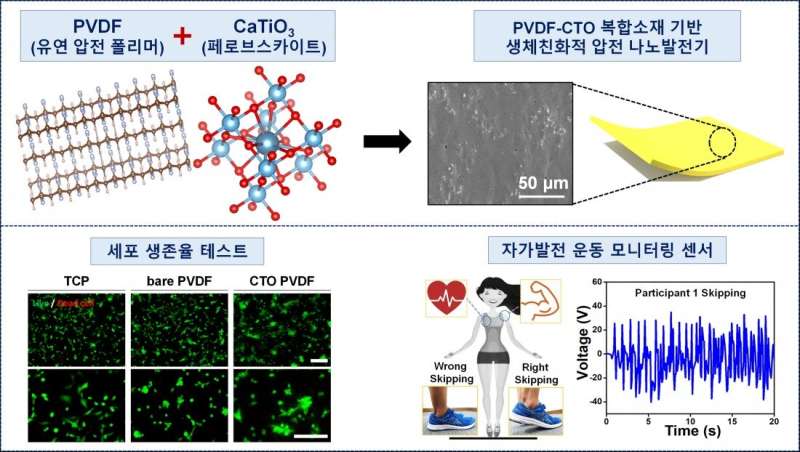Bio-friendly, self-powered sensor technology that can accurately analyze exercise posture

A joint research team led by Professor Kim Hoe-joon of the Department of Robotics and Mechatronics Engineering and Professor Hong Seon-ki of the Department of Physics and Chemistry has developed a high-efficiency piezoelectric energy harvesting technology using biocompatible perovskite materials.
The work is published in the journal Nano Energy.
Piezoelectric energy harvesting technology, which converts physical energy sources, such as body movements, into electric energy, is regarded as a next-generation energy source because of its high energy efficiency and availability of various materials. However, most existing piezoelectric materials contain lead, which is harmful to the human body. For that, piezoelectric energy harvesting technology has been used as a power source for small electronic devices, but there were safety and health issues.
To break through the limitations of these existing technologies and materials, the research team synthesized CTO materials with excellent piezoelectric properties among biocompatible materials applicable to the human body and analyzed its detailed electrical, physical, and thermal characteristics. In addition, the team succeeded in developing a composite material that is flexible and strong against external impact by mixing it with PVDF material, which is a piezoelectric polymer.
A cell viability test was conducted to verify biocompatible properties. As a result, the composite material developed showed a high survival rate and cell fertility, indicating that there will be no problem even when applied to the human body.
The newly developed piezoelectric energy generation device achieved a maximum voltage of 20V and current of 250nA, allowing it to be used as a power source for small electronic devices such as electronic calculators and wristwatches. In addition, it is expected that it can be used in a broad range of applications by verifying the possibility of using it in a self-powered vibration sensor that harvests kinetic energy generated from the vibration of an object.
As the material applied in this study is suitable for the human body, it can harvest energy in real-time from walking and body movement while attached to a body part. In particular, it also suggested the possibility of using it as a self-powered sensor that evaluates the user's exercise ability and jump-rope posture by attaching a sensor to the sole of the foot and performing a simple jumping rope exercise.
Measurements taken by using an artificial neural network (ANN) analysis technique for efficient diagnosis of exercise posture showed that it was possible to determine whether the exercise posture was right or wrong with a high success rate of 99.63%.
Professor Kim Hoe-joon of the Department of Robotics and Mechatronics Engineering said, "We proved that even bio-friendly materials have excellent piezoelectric properties, and there is a great significance to this as we can overcome the limitations of existing materials." He added, "we will challenge the development of next-generation eco-friendly energy sources based on this result and continue research on self-powered sensor systems that do not require external power."
More information: Swati Panda et al, Biocompatible CaTiO3-PVDF composite-based piezoelectric nanogenerator for exercise evaluation and energy harvesting, Nano Energy (2022). DOI: 10.1016/j.nanoen.2022.107682


















